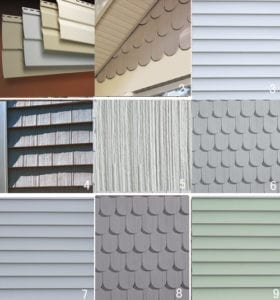
Buyer’s Guide to the Cheapest Home Siding Options
Understanding Home Siding
Home siding is a crucial component of your house’s exterior, offering both aesthetic appeal and protection from the elements. When considering siding, homeowners should assess factors like durability, maintenance, energy efficiency, aesthetic appeal, and, importantly, cost. The right siding can significantly enhance your home’s curb appeal and resale value while providing adequate insulation and protection.
Factors to Consider
- Durability and Maintenance: Some siding materials are more durable and require less maintenance than others. Consider the local climate and the amount of upkeep you’re willing to undertake.
- Energy Efficiency: Siding can play a significant role in your home’s insulation and energy costs. Materials with good insulation properties can save money in the long run.
- Aesthetic Appeal: The siding should complement your home’s architectural style and the surrounding neighborhood.
- Installation Costs: These can vary widely depending on the material and the complexity of the installation process.
Siding Options: From Most Affordable to More Expensive
Vinyl Siding
- Cost: Vinyl is known for being the most cost-effective siding option. Prices vary depending on quality, but it’s generally the cheapest.
- Durability: Resistant to pests and rot, it can last for decades with minimal maintenance.
- Maintenance: Requires occasional cleaning with soap and water.
- Pros: Wide range of colors and styles, low maintenance, and easy installation.
- Cons: Can crack in extreme cold, may fade over time, and doesn’t offer as much insulation as other options.
Aluminum Siding
- Cost: Slightly more expensive than vinyl but still budget-friendly.
- Durability: Resistant to fire, rot, and pests. It can dent and may corrode in coastal areas.
- Maintenance: Requires periodic painting to maintain appearance.
- Pros: Fire-resistant, recyclable, and low maintenance.
- Cons: Prone to dents, noise (from rain or hail), and color fading.
Fiber Cement Siding
- Cost: More expensive than vinyl and aluminum but offers better durability.
- Durability: Resistant to fire, termites, rot, and weather damage.
- Maintenance: Needs occasional repainting and caulking.
- Pros: Mimics the look of wood, fire-resistant, and termite-proof.
- Cons: Requires professional installation, can be expensive, and is heavier than other materials.

Wood Siding
- Cost: Ranges from mid to high, depending on the type of wood.
- Durability: Susceptible to rot, pests, and requires more maintenance.
- Maintenance: Needs regular painting, staining, and treatment against pests and rot.
- Pros: Timeless aesthetic, eco-friendly, and offers excellent insulation.
- Cons: High maintenance, can be expensive, and is not fire-resistant.
Engineered Wood Siding
- Cost: More affordable than natural wood but more expensive than vinyl or aluminum.
- Durability: More durable than natural wood; resistant to rot and pests.
- Maintenance: Requires less maintenance than natural wood.
- Pros: Offers the look of natural wood at a lower cost, eco-friendly.
- Cons: Some products may have quality variations.
Brick and Stone Veneer
- Cost: Among the most expensive siding options.
- Durability: Extremely durable, resistant to fire, pests, and weather.
- Maintenance: Virtually maintenance-free.
- Pros: Adds significant curb appeal and resale value, highly durable.
- Cons: High installation cost, requires a strong structural support.
Stucco
- Cost: Can be expensive, depending on the application process.
- Durability: Very durable if properly maintained.
- Maintenance: Requires occasional patching and painting.
- Pros: Provides a unique look, great for insulation.
- Cons: May crack in certain climates, labor-intensive installation.
Choosing the right siding involves balancing cost, aesthetics, durability, and maintenance. Vinyl and aluminum offer great cost-effectiveness with reasonable durability. Fiber cement, while pricier, provides a balance of durability and aesthetic appeal. Wood and engineered wood offer classic beauty but require more upkeep. For high-end options, brick, stone veneer, and stucco offer exceptional durability and aesthetic appeal but at a higher cost. Always consider your local climate, the architectural style of your home, and long-term maintenance requirements when making your decision.
Identifying When to Replace Your Home Siding
Knowing when to replace your siding is crucial for maintaining your home’s integrity and appearance. Here are key indicators that suggest it might be time for a siding replacement:
Visible Damage:
The most obvious sign is visible damage. Look for cracks, dents, chips, or significant fading. In wood siding, indications like warping, rot, or wood that easily crumbles upon poking are red flags. For materials like vinyl or aluminum, look for deformities like bending or dents.
Increased Heating or Cooling Bills:
If you notice a sudden spike in your heating or cooling costs, it could be due to poor insulation from your siding. Efficient siding plays a significant role in regulating your home’s temperature.

Moisture and Mold:
Signs of moisture, such as bubbling or blistering paint, mold, mildew, or fungus growth on or near the siding, are critical concerns. These issues can lead to more significant structural damage if not addressed.
Interior Damage:
Sometimes the signs are visible from inside your home. Wallpaper or paint that is peeling off can be a symptom of faulty siding allowing moisture to seep into the wallboard.

Frequent Need for Painting:
If your siding needs frequent painting, it’s a sign that it is no longer performing effectively. Good siding should keep its shape and color for at least 8-10 years, if not longer.
Fading Color:
Excessive fading can indicate the material’s age and deterioration. Most siding is designed to hold its color for the duration of its lifespan. If the color is severely faded, it’s a good hint that the protective qualities may be compromised.
Rot or Insect Damage:
In wood siding, be on the lookout for signs of rot or insect damage. If the lower sections of the siding are beginning to crumble or show signs of insect invasion, it’s time to consider a replacement.
Warped or Bulging Panels:
This can be a sign of a serious underlying issue, like water infiltration. Inspect any warped siding closely to determine if there is a deeper problem beneath.
Higher Maintenance:
If you’re spending more time and money on maintaining your siding than would be reasonable, it could be more cost-effective to replace it.
Age of Siding:
Consider the age of your siding. Most types have a certain lifespan, after which they will start to deteriorate. Knowing when your siding was installed and the typical lifespan of the material can help you decide if it’s time for a replacement.
The Importance of Timely Replacement
Delaying the replacement of your siding can lead to more significant problems, such as structural damage or increased energy costs. If you’re unsure about the condition of your siding, it may be worthwhile to have a professional inspection. This can provide a clear assessment of your siding’s condition and help you make an informed decision about whether to repair or replace it.
Remember, new siding can greatly enhance your home’s curb appeal and overall value, making it a worthwhile investment, especially if your current siding is showing clear signs of wear and tear.
Leave a Reply